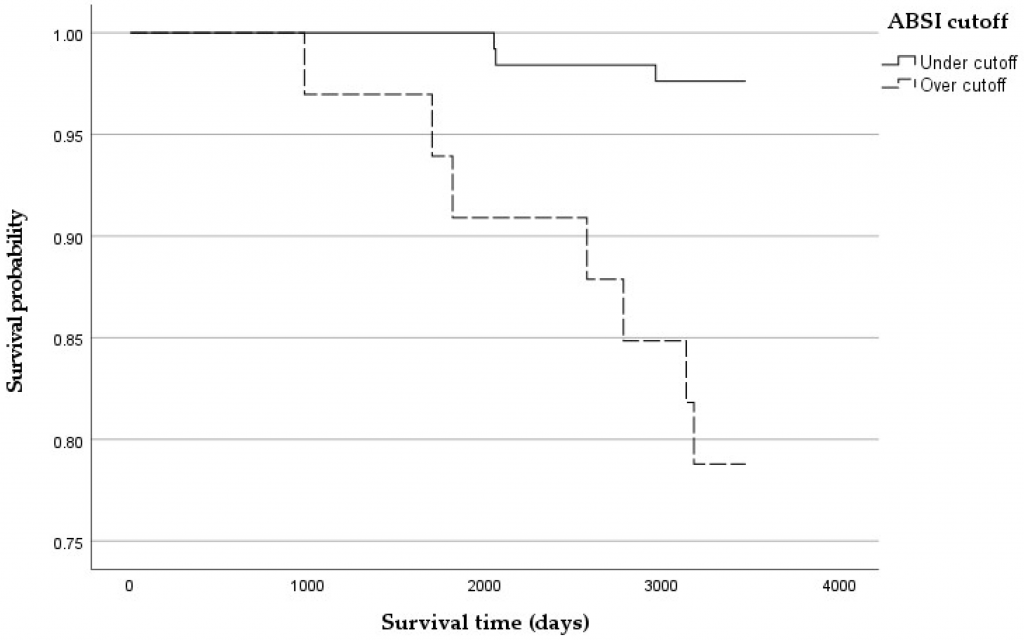Key Points:
- In somewhat healthy older adults, a larger waistline is associated with a shorter life expectancy.
- The age-accelerating effects of abdominal fat may be mitigated by compounds called senolytics, which get rid of age-promoting senescent cells.
Most previous studies have failed to accurately capture the effect of abdominal fat on the risk of early death, especially in individuals who are not obese. For this reason, Italian and Slovenian researchers have utilized a new measurement that captures the effect of abdominal fat. In doing so, they found that abdominal fat is associated with a 365% increase in the risk of early death.
Fat Around Waist Shortens Lifespan
The researchers utilized a new measurement, A Body Shape Index (ABSI), based on waist circumference, weight, and height. ABSI does not incorporate Body Mass Index (BMI), which fails to capture fat distribution or differentiate between muscle and fat. Likewise, measurements like waist circumference and waist-to-hip ratio do not effectively reflect body composition.
The participants of the study were 159 elderly, non-obese, physically active adults without significant health problems. However, 50% of participants were active smokers, 30% had high blood pressure and were taking blood pressure-lowering drugs, and 15% were taking cholesterol-lowering drugs. The average ABSI, which can be calculated here, of the participants was 0.081 m1/2/kg2/3.
In addition to measuring ABSI, the researchers measured the participants’ VO2 max (maximum volume of oxygen utilization), an indicator of cardiovascular fitness that can predict life expectancy. Moreover, lower ABSI scores were linked to higher VO2 max levels and lower blood pressure, suggesting that lower abdominal fat is associated with better aerobic capacity and heart health.
The mortality rates of the participants were measured after a 10-year follow-up, in which time 10 of the participants died. Using a machine learning technique, the researchers determined an ABSI cutoff point to compare participants based on high or low ABSI scores. In doing so, the researchers were able to estimate the probability of survival for participants with high or low abdominal fat.

Using the ABSI cutoff value (based on the statistical value of 0.77), the researcher calculated a hazard ratio of 4.65, corresponding to a 365% increase in the likelihood of mortality. Further analysis showed that, in males, higher grip strength was associated with lower ABSI scores, suggesting the association between muscle mass and strength in having low abdominal fat. However, this association was not found in females.
Alleviating the Age-Accelerating Effects of Abdominal Fat with Senolytics
Chronic inflammation is an underlying biological driver of aging associated with age-related conditions such as cardiovascular disease and diabetes. Studies show that immune cells called macrophages found within excess fat tissue promote this inflammation. Inflammation is also elevated by senescent cells, which accumulate in the visceral fat of obese individuals. Senescent cells not only attract macrophages but also secrete pro-inflammatory molecules.
Reducing the number of senescent cells harbored in excess abdominal fat may alleviate the age-accelerating effects of chronic inflammation. Supporting this idea, senolytics — compounds that remove senescent cells — have been shown to reduce senescent cells, the pro-inflammatory factors they secrete, and the macrophages they attract in the fat tissue of individuals with diabetes-induced kidney disease. Thus, the same effect may be achieved in non-obese, generally healthy individuals with excess abdominal fat.
Furthermore, according to preclinical studies, naturally occurring senolytics called polyphenols may aid against the pro-inflammatory effects of excess abdominal fat and obesity. These polyphenols include quercetin, fisetin, curcumin, rosmarinic acid, resveratrol, epigallocatechin gallate, apigenin, and olive-derived polyphenols. These senolytic polyphenols can be found in plant-based foods, especially fruits and vegetables. Moreover, larger doses can be consumed via supplementation.